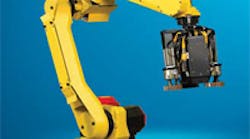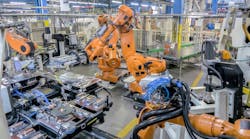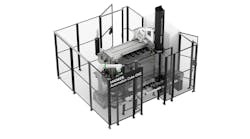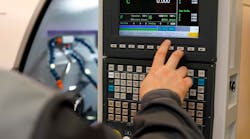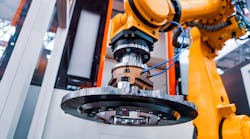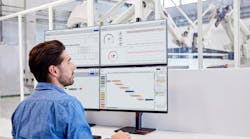| Company / machine model | Fanuc Robotics America Inc./M-10iA | Kawasaki Robotics (USA) Inc./FS06N | Motoman/HP20 |
| Payload | 10 kg | 6 kg | 20 kg |
| Moment of inertia | J4- 0.63 kg-m2, J5 – 0.63 kg-m2, J6 – 0.15 kg-m2 | JT4 0.24 kg-m2, JT5 0.24 kg-m2, JT6 0.07 kg-m2 | R(J4) 0.9 kg-m2, B(J5) 0.9 kg-m2, T(J6) 0.25 kg-m2 |
| Vision system | iRVision from Fanuc standard on all models, which also are compatible with many 3rd party vision systems. | Company offers 2D and 3D integrated vision systems and vision components by Cognex, DVT and other suppliers. | Vision systems supplied by Motoman, Cognex, Omron, and National Instruments. |
| Integration | Various types offered, such as Ethernet I/P, DeviceNet and ProfiBus. Custom interfaces for Fanuc controlled machines and other special machine controls also available. | AS Language text-based programming standard. PC (process control) and KLogic (Ladder language programming) for cell control. Soft Interface for custom operator interfaces. Supported Fieldbus options include Ehternet IP Scanner and Adaptor, DeviceNet Master and Slave, Profibus Master and Slave, Interbus-S, CC Link, RIO, and Discrete I/O. | EasyLoad conversational programming software for robot-ready SL and VF-series Haas machines with automatic doors. Standard interfaces to Mazak, Okuma, Haas and Daewoo machines. |
| Other special software features | Softfloat for relaxing robot axes to prevent part misloading. Singularity Avoidance to simplify robot programming. Dual Check Safety Speed and Position Check software for using the robot itself, instead of external devices, for some safety functions, such as restricting its travel. Collision Guard to sense potential collisions and minimize damage. | Block Step programming for task programs using a teach pendant to create paths for automatic cycles. | Servo float, collision avoidance, collision detection, multiple robot control (to 4 robots), and advanced robot motion. |
| Repeatability | +/- 0.08 mm | +/- 0.05 mm | 0.08 mm |
| Mounting configuration | Floor, ceiling, angle, and wall | Floor, ceiling and wall. | Floor, angle, wall, and inverted mounting. |
| Website | www.fanucrobotics.com | www.kawasakirobotics.com | www.motoman.com |
Machine-tending robots provide more overall process accuracy, minimize the chance of parts being loaded incorrectly, speed part cycles, reduce labor costs and ease troubleshooting production problems because the human element has been taken out of the equation.
Most often, shops install machine tending robots for turning applications, and common robot payloads for those installations range from 5 kg to 10 kg. However robot OEMs offer robots for handling every part size to 1,200 kg.
When selecting the proper payload for a turning machine-tending robot, shops must take into account that the robot will usually be carrying two parts simultaneously – a raw part for loading and a finished one being unloaded. And the robot’s gripping tool weight must also be figured into the calculations.
In addition, robot OEMs recommend that shops match a machine-tending robot to the turning machine it will be tending. Consider the biggest part that could be run on the machine, then choose a robot according to that part weight. Size the robot to the machine and not exclusively to the initial part intended to be run.
Along with payload, a robot’s moment-of-inertia rating needs to be considered. This rating indicates how far away from its faceplate a robot can place the payload. A high moment-of-inertia rating allows payloads to be placed further away from a robot’s faceplate.
There are also other features to look into when deciding on a machine-tending robot. These include repeatability, how accurately the robot moves back and forth to the same position/location; type of vision system, its availability and who supplies it; special software features that are offered; and how the robot integrates with the intended machine tool.
Shops need to ensure that the robot they are considering will easily communicate/interface with any older machine tools the shop may want to automate and with the different machine tool controls that are available in today’s market.
